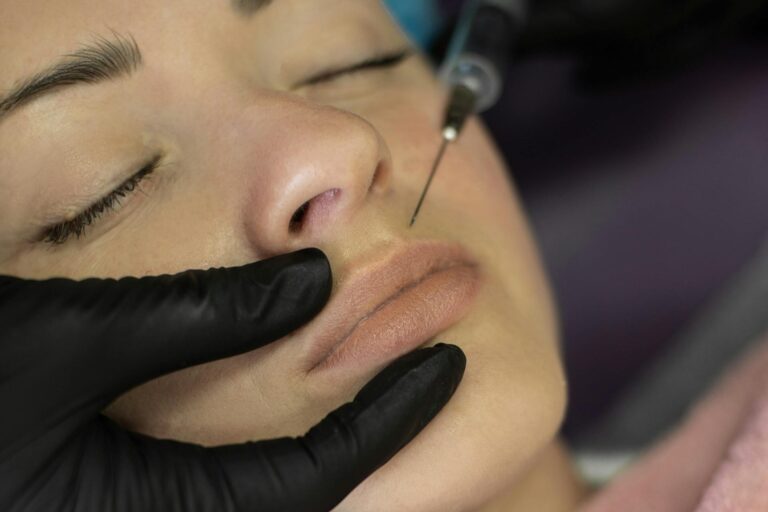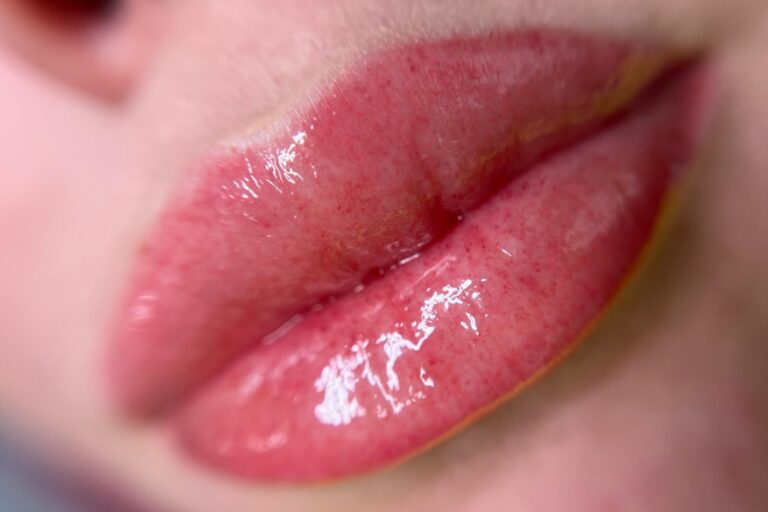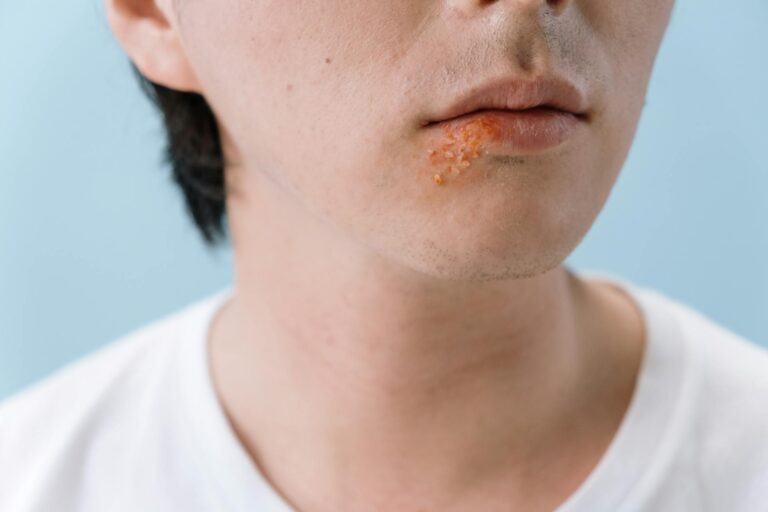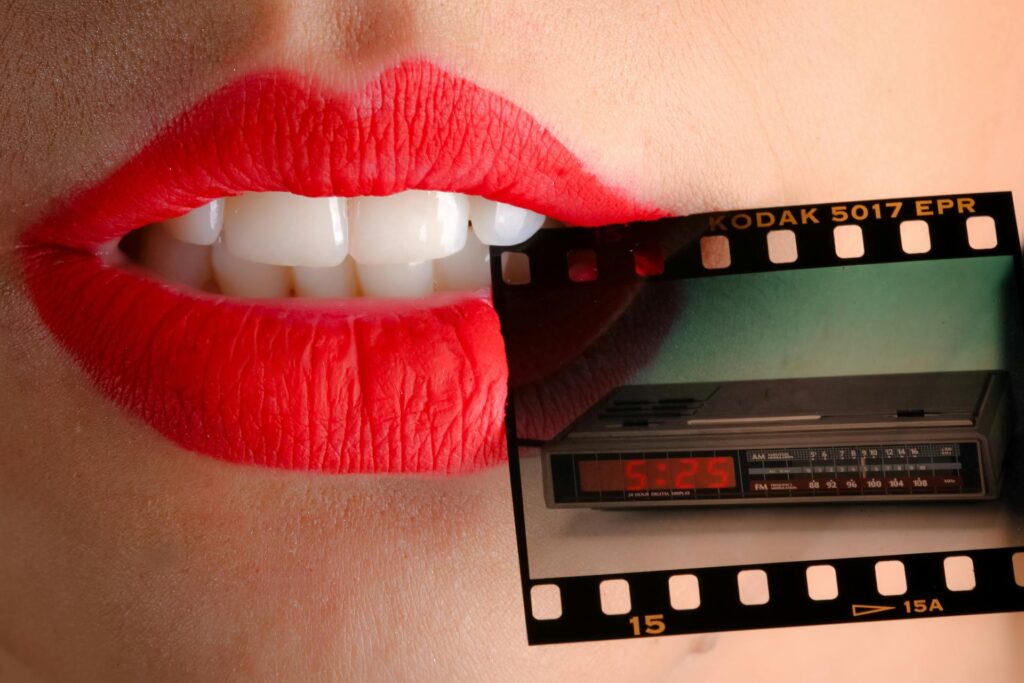
Lip fillers have gained significant popularity among individuals seeking to enhance the fullness and shape of their lips. Whether motivated by current beauty trends or a desire for increased personal confidence, many are opting for this cosmetic procedure.
This guide provides comprehensive information about lip fillers, including the various types available, an overview of the procedure, and what one can expect during the recovery process. Additionally, it includes essential lip filler aftercare tips to help achieve optimal results and minimise side effects.
What Are Lip Fillers?
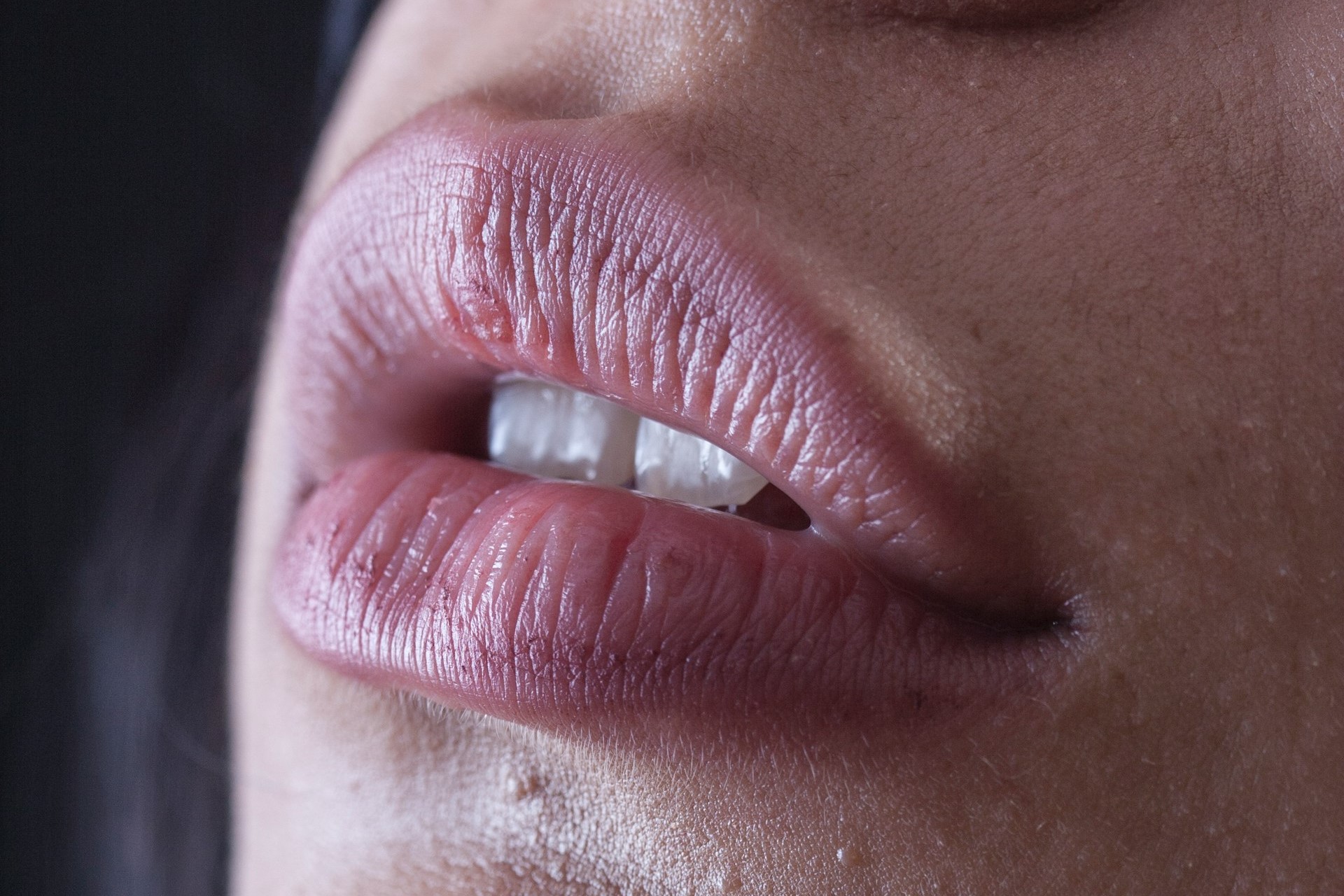
Lip fillers have become a widely sought-after non-surgical cosmetic procedure. This treatment involves the injection of dermal fillers into the lips to enhance their volume and contour, resulting in a fuller and more defined look.
Many individuals are drawn to this option because it provides a quick and effective solution for those seeking lip rejuvenation. What is particularly appealing is the ability to customise the treatment to align with each person’s aesthetic goals.
With a variety of fillers available on the market, patients have the opportunity to achieve different results based on their unique lip anatomy and desired outcomes.
Why Do People Get Lip Fillers?
Individuals choose to pursue lip fillers for a variety of reasons, including enhancing lip volume and achieving a more balanced lip contour that aligns with their aesthetic goals. Many patients are driven by the desire for a natural look, allowing them to attain fuller lips without the need for invasive surgery.
Whether it is to address volume loss due to ageing or simply to improve their appearance, lip fillers present a versatile option for those looking to boost their confidence. For many, the cost of lip fillers in the UK is seen as a valuable investment in self-care, with the procedure offering both physical enhancements and emotional benefits.
The decision to opt for lip fillers often intersects with societal beauty standards that favour plump, symmetrical lips as symbols of youth and attractiveness. This pursuit of physical perfection can have a notable impact on self-esteem, leading many to seek treatments that promise not only to enhance their looks but also to elevate their mood and self-image.
Psychological factors, such as the desire for social acceptance and the fear of ageing, often play a significant role in guiding individuals toward this choice. The emotional benefits of lip fillers can extend far beyond aesthetic transformation, making the treatment a means of aligning one’s appearance with personal ideals of beauty.
What Are the Different Types of Lip Fillers?
There are several types of lip fillers available, each designed with different substances to achieve a range of results. Among these, hyaluronic acid-based fillers are the most popular choice due to their natural-looking outcomes and the fact that they can be reversed if necessary.
Other fillers may utilise collagen or various compounds, offering unique benefits tailored to individual needs and preferences. Selecting the right type of filler is crucial to ensuring that the treatment aligns with the patient’s aesthetic goals and expectations.
Hyaluronic acid fillers stand out particularly for their ability to enhance lip volume while attracting moisture, which helps maintain hydration and fullness over time. In contrast, collagen-based fillers can provide more structured support, but they may not deliver the same longevity or natural feel as hyaluronic options.
It is essential for potential patients to consult with a qualified professional who can evaluate their facial anatomy and discuss the advantages and disadvantages of each filler type.
With expert guidance, individuals can choose a product that not only meets their desired outcomes but also minimises potential risks associated with the procedure, such as allergic reactions or uneven results.
What to Expect During and After the Lip Filler Procedure?

When considering the lip filler procedure, patients can anticipate a clear and straightforward experience. It typically starts with a consultation to discuss their goals and the techniques that will be employed to achieve the desired results.
The procedure generally involves applying anaesthetic to reduce any discomfort, followed by the meticulous injection of dermal fillers into specific areas of the lips. This precise approach allows for controlled enhancement of both volume and contour, ensuring the transformation aligns with the patient’s expectations.
One of the most exciting aspects of the journey is seeing the before and after lip fillers transformation, as patients often note a significant improvement in lip definition and overall facial harmony. Following the treatment, some temporary swelling and tenderness during the recovery period are common. However, with appropriate aftercare, patients can look forward to gratifying results that enhance their natural beauty.
How Long Do Lip Fillers Last?
The duration of lip fillers can vary based on several factors, including the type of filler used and the individual’s metabolism. Typically, results can last anywhere from six months to a year, after which maintenance or top-ups may be necessary to maintain optimal volume and contour.
It is important for patients to recognise that, while certain fillers may provide longer-lasting effects, regular maintenance appointments are crucial for sustaining the desired appearance and ensuring ongoing satisfaction with their lip enhancement. Addressing myths about lip fillers, such as the misconception that they always require constant upkeep, helps individuals make informed decisions and better understand the realistic timeline for top-ups and maintenance.
Lifestyle choices significantly influence the longevity of these enhancements. Factors such as smoking, sun exposure, and hydration levels can affect skin elasticity and, consequently, the durability of the filler. Additionally, different skin types may respond differently to fillers, with some individuals experiencing faster absorption rates than others.
The choice of filler—whether it is hyaluronic acid-based or a longer-lasting alternative—also plays a critical role in how well the enhancements maintain their effectiveness over time. Understanding these factors highlights the importance of continuous care and timely top-ups, allowing individuals to enjoy beautifully enhanced lips for as long as possible.
What Are the Common Side Effects of Lip Fillers?
Common side effects of lip fillers typically include temporary swelling, bruising, and tenderness around the injection sites. These effects are usually mild and tend to subside within a few days as the lips begin to heal.
Patients should be aware, however, that there is a potential for more serious side effects, such as allergic reactions or other complications. It is advisable to seek medical attention if any unusual symptoms arise following the treatment.
In some cases, individuals may experience prolonged swelling, lumps, or even persistent pain. It is important for anyone who undergoes lip filler procedures to diligently monitor their symptoms and understand when it is necessary to reach out for assistance. Being aware of the signs of infection, such as increased redness or warmth around the lips, can be crucial.
To minimise risks, adhering to preventative measures and following the post-treatment care instructions provided by the practitioner is essential for ensuring a safe and satisfactory outcome. This includes avoiding excessive sun exposure and refraining from strenuous activities immediately after the procedure.
What Is the Aftercare Process for Lip Fillers?

After receiving lip fillers, it is crucial to follow proper aftercare to promote healing and minimise potential side effects such as swelling and bruising. This ensures that patients achieve the best possible results from their cosmetic procedure.
Important aftercare practices include:
- staying hydrated,
- using ice packs to reduce swelling,
- adhering to medical advice regarding pain relief and infection prevention.
Moreover, scheduling a follow-up appointment with the practitioner provides an opportunity to evaluate the results and make any necessary adjustments.
What to Do Immediately After the Procedure?
Immediately following the lip filler procedure, it is essential for patients to follow specific aftercare instructions to ensure a smooth recovery. This includes applying ice packs to the treated areas to minimise swelling and keeping the lips well-hydrated. Such precautions not only help reduce bruising but also enhance the overall healing process, allowing the results of the treatment to shine.
Along with these crucial steps, maintaining hydration is important; patients should drink plenty of water and avoid excessive salt and alcohol, as these can increase swelling. It is also advisable for patients to be mindful of their physical activities, as adequate rest plays a significant role in achieving the best outcomes.
Avoiding direct sunlight and strenuous exercise for the first few days after the procedure is key to preventing complications. Adhering to these aftercare guidelines is vital for a successful recovery. By prioritising these recommendations, individuals can create an optimal environment for their beautiful new lips.
How to Reduce Swelling and Bruising?
To effectively reduce swelling and bruising after receiving lip fillers, patients are encouraged to apply ice packs intermittently to the treated areas. This technique helps constrict blood vessels, minimising discomfort during the healing process. Practitioners may also recommend over-the-counter pain relief options to alleviate any tenderness, ensuring a more comfortable recovery experience as the lips heal.
Along with cold therapy, it is essential for individuals to consider lifestyle adjustments that promote better healing. Staying hydrated can assist in reducing inflammation, and it is crucial to avoid alcohol and caffeine for a few days after the treatment, as these substances can exacerbate swelling.
Incorporating arnica gel or bromelain supplements may also be beneficial, as they are recognised for their anti-bruising properties. Following a proper recovery timeline and being gentle with the treated area is important, as strenuous activities could negatively impact the healing process.
By adopting these strategies, patients can enhance their overall comfort and expedite their return to normality.
What Foods and Drinks Should Be Avoided?
After receiving lip fillers, it is advisable to avoid certain foods and drinks that may increase swelling or irritation. This includes abstaining from alcohol and spicy foods, as they can interfere with the healing process.
Additionally, quitting smoking is crucial; smoking can hinder blood circulation and negatively impact the results of the cosmetic treatment.
To support optimal healing, limiting the intake of sugary foods and refined carbohydrates is also important, as these can contribute to inflammation in the body. Reducing caffeine consumption can be beneficial as well, since it may dehydrate the skin and make it more difficult for the tissue to recover.
Staying well-hydrated by drinking plenty of water is essential, as it helps flush out toxins and maintain skin elasticity.
Incorporating foods rich in vitamins A and C, such as leafy greens and citrus fruits, can further enhance the healing process by promoting collagen production. Adopting these lifestyle adjustments is vital for ensuring not only immediate results but also long-term satisfaction with cosmetic enhancements.
When Can I Wear Makeup Again?
Patients often find themselves eager to return to their regular skincare routines, including the use of makeup. However, it is generally advisable to wait at least 24 hours after the lip filler procedure before doing so. This waiting period allows the injection sites to heal properly.
Adhering to aftercare instructions regarding makeup use is essential, as it helps prevent irritation and supports optimal recovery.
After this initial 24-hour period, individuals should gradually reintroduce gentle, non-irritating products into their routine. It is important to prioritise a comprehensive skincare regimen that includes moisturisers and serums, as these can hydrate and nourish the skin, promoting a healthier recovery.
In the first few days following the procedure, avoiding heavy makeup application can significantly reduce the risk of infections and other complications. Creating a comfortable environment—such as keeping the skin clean and applying cold compresses if necessary—also contributes to a smoother healing process, allowing individuals to ease back into their cherished beauty rituals.
Tips for a Smooth Recovery

To facilitate a smooth recovery after receiving lip fillers, it is important for patients to prioritise hydration techniques, utilise appropriate skincare products, and follow medical advice for long-term care.
Staying well-hydrated plays a crucial role in supporting the healing process, and employing recommended moisturisers can help preserve lip softness and definition.
Educating patients about their recovery journey is essential, as it ensures that individuals are fully informed and equipped to achieve the best possible results.
How to Keep Your Lips Hydrated?
Maintaining hydration of your lips after treatment is essential for preserving their plumpness and softness. This can be effectively achieved by regularly applying high-quality moisturisers or balms specifically designed for lip care. Additionally, incorporating essential oils into your skincare routine can offer extra hydration and nourishment to support the healing process.
To further enhance your hydration efforts, it is advisable to select products containing ingredients such as hyaluronic acid and shea butter, as these are known for their ability to lock in moisture. When applying these products, using a gentle dabbing technique with your fingertip can help evenly distribute the product and stimulate blood flow, promoting a healthy appearance.
It is also beneficial to reapply throughout the day, particularly after meals or drinks, to ensure your lips remain consistently moisturised.
Moreover, keeping hydrated internally by drinking plenty of water is equally important, as it contributes significantly to the overall rejuvenation and care of the lips during the recovery period.
What Are the Best Products to Use for Lip Filler Aftercare?
Using the appropriate skincare products for lip filler aftercare can greatly influence the healing process. Recommended items typically include gentle moisturisers and topical ointments specifically formulated to soothe and protect the lips. It is also important to conduct allergy testing for any new products to avoid adverse reactions that could complicate recovery.
There are several beneficial products available that emphasise hydration and nourishment.
- For example, hyaluronic acid-based serums are renowned for their exceptional moisture-retaining properties, which can help reduce swelling and improve skin elasticity.
- Aloe vera gels can also be advantageous, thanks to their calming and anti-inflammatory properties that promote quicker recovery.
- Additionally, products containing vitamin E can support skin repair, offering antioxidant protection against environmental stressors.
Following safe skincare practices after treatment is essential. This includes avoiding harsh chemicals and excessive sun exposure to ensure the delicate lip area heals properly while maintaining a healthy and plump appearance.
When Can I Resume Normal Activities?
The downtime associated with lip filler procedures is typically minimal, with most patients able to return to their normal activities within a day or two. However, it is advisable to avoid strenuous exercise and heavy lifting for at least a week to ensure proper healing.
Adhering to the recommended recovery timeline and following patient guidance helps to achieve optimal results while minimising the risk of complications.
It is important for individuals to be patient during this recovery phase, as the healing process can vary from person to person. After a brief period, engaging in low-impact activities is encouraged, but it is essential to prioritise the advice provided by medical professionals.
They offer tailored recommendations based on individual health status and the specific type of filler used, which can significantly influence overall outcomes.
By following these guidelines and allowing sufficient time for the body to recuperate, individuals can lay the groundwork for achieving their desired aesthetic results while also protecting against any potential setbacks.
What Are the Signs of Complications?
Being aware of the signs of complications after lip filler treatment is essential for ensuring patient safety. Symptoms such as severe swelling, persistent pain, or unusual discolouration should prompt an immediate consultation with a healthcare professional.
Infection prevention measures are crucial during the recovery process, and recognising allergic reactions can help mitigate the risks associated with non-surgical cosmetic procedures.
Monitoring for these symptoms after treatment can offer peace of mind, as early detection often leads to more effective interventions. If any of these concerns arise, it is important to contact qualified professionals for guidance, as they are equipped to assess the situation thoroughly.
Maintaining open communication about any pre-existing medical conditions or allergies before the procedure can assist practitioners in minimising complications. Proactive safety measures, such as diligently following aftercare instructions and attending follow-up appointments, play a vital role in enjoying the benefits of lip fillers while prioritising overall well-being.
Final Thoughts

Lip fillers present a viable option for those looking to enhance the volume and definition of their lips, ultimately leading to increased patient satisfaction and aesthetic outcomes when administered by a qualified professional.
The effectiveness of these treatments relies not only on the provider’s expertise but also on the patient’s informed decisions regarding their aesthetic goals.
It is essential for individuals to thoroughly research the procedure, understand the potential results, and engage in meaningful discussions about their aspirations during consultations. Open communication with experienced practitioners is crucial, as it fosters a tailored approach that aligns with personal preferences.
By prioritising safety and seeking professional guidance, individuals interested in lip filler treatments can enhance their confidence while achieving the natural look they desire, navigating their journey with both clarity and assurance.
Frequently Asked Questions
What is the purpose of The Lip Filler Aftercare Guide?
The Lip Filler Aftercare Guide: Tips for a Smooth Recovery is designed to provide you with useful tips and information to help you recover from your lip filler treatment with minimal discomfort and optimal results.
When should I start following The Lip Filler Aftercare Guide?
It is recommended to start following The Lip Filler Aftercare Guide immediately after your lip filler treatment to ensure a smooth recovery and long-lasting results.
Can I take pain medication after my lip filler treatment?
If you experience any discomfort after your lip filler treatment, you can take over-the-counter pain medication such as ibuprofen. However, it is best to consult with your doctor first to ensure it is safe for you.
Can I wear makeup on my lips after getting lip filler?
It is best to avoid wearing makeup on your lips for at least 24 hours after your lip filler treatment to allow the area to properly heal. Once the initial swelling and bruising has subsided, you can resume wearing makeup as usual.
How can I reduce swelling after my lip filler treatment?
To reduce swelling, you can apply a cold compress to your lips for 10-15 minutes at a time. You can also take an anti-inflammatory medication, such as ibuprofen, as directed by your doctor.
How long do I have to wait before seeing the final results of my lip filler treatment?
It can take up to two weeks to see the final results of your lip filler treatment as the swelling and bruising subside and the filler settles into place. It is important to have patience and follow The Lip Filler Aftercare Guide for optimal results.
